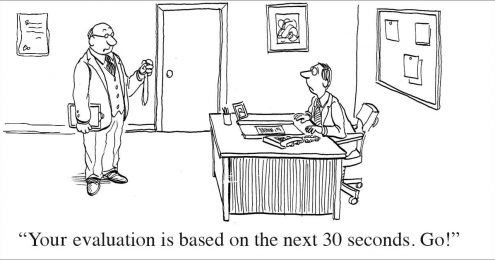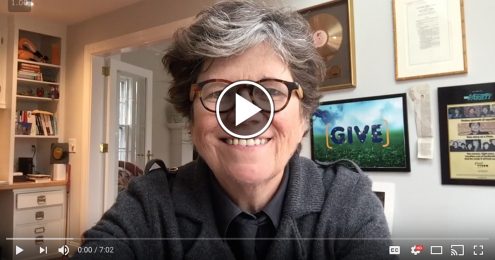Does your nonprofit already have an inspiring, helpful, put-together board orientation program for new board members? If yes, you get a big hug from me. Well done.
This post isn’t for you. Instead, consider reading Critical Interview Questions for New Board Members (a very popular post I wrote that helps you figure out what to ask people you are considering for your board.)
For the 95% of you that are still here… well, we have some important work to do.
Healthy nonprofits have great boards that work hand-in-hand with the Executive Director to help fulfill the mission.
In order to have a great board, a nonprofit needs board members who are engaged, inspired, and understand how to help. This is true for long-standing board members. This is especially true for brand new ones.
So why don’t you have a great board orientation program? The main objection I hear is time. You wish you had a moment to pee, no less pull together a board orientation package.
Today I’m going to show you exactly how to create such a package, step-by-step. By the end of this, you will have no excuse. You will see very clearly why this is so important. And you’ll be fired up to do it.
My board orientation template works for tiny one-person nonprofits just as well as it does for large ones. In fact, for smaller nonprofits, it’s especially easy to put together.
So here we go…
NEW BOARD MEMBER ORIENTATION FAIL
First, let me tell you the true story of “Sofia” and her recent experience when she joined a board.
Sofia had been involved as a donor to the organization. She enthusiastically agreed to join the board because she believed she could make a difference.
During the recruitment process, she received some basic materials about the “job,” most specifically a document outlining roles and responsibilities. Score one for this organization.
Time for her first board meeting.
Even though there was a class of new board members joining at the same time, there had been no separate gathering to provide any information to enable them to hit the ground running.
Nevertheless, Sofia walked into the meeting feeling excited. She was pointed to a table of binders, each with a name on it. “My board orientation pack,” she thinks. But there was no binder for her.
“Oh, just take Daniel’s – he’s not coming tonight.” Daniel has been on the board for years.
The binder contained a wealth of current and past information, including many pages of past board meeting minutes. But there was no time to review it before the board meeting started.
Sofia was lost – it’s like she started reading a book in the fourteenth chapter.
She discovered that decisions were often made by mysterious committees. There was an executive committee. It seemed to have a lot of power. She wasn’t too sure who was on it.
The committees weren’t the only mystery. The most baffling one came at the end of the evening when all binders were to be returned to the table. You couldn’t take them home. The only explanation was that board members would not return them and they’d have to make new copies.
How long do you think Sofia lasted on the board? Let me just say that she didn’t make it past her first term.
This story makes me mad. Sofia was more engaged before joining the board than after leaving. Nonprofits can ill afford to lose one single person who raises her hand or opens her checkbook.
A new board member needs so much more than this. The job is fuzzy to begin with. And oh, let’s not forget that they already have a job.
So I don’t care what size your organization is, you need to do SOMETHING. You need the board member to have context, information and color commentary so she doesn’t have to try pick it up by osmosis.
JOAN’S SIMPLE AND EFFECTIVE BOARD ORIENTATION PLAN
Now we get to the meat… the plan itself. My plan has two parts – 1) The Binder and 2) The Session.
The point of each is to make sure new board members feel the following:
- Well informed about their role
- Generally well informed about how the organization operates
- Who’s who
- Proud and able to share a few key accomplishments of the organization as they begin to tell friends, family and colleagues about their new gig
- Ready to contribute on day one
- Impressed that they have joined a professional organization
- Valued and appreciated
Board members who walk through the doors feeling this way are your most engaged and productive board members. They are your future leaders.
I’ll explain each part of the plan in turn.
THE BOARD ORIENTATION BINDER
The Binder is specifically for brand new board members and it is for them to take home to read, review, take notes, and write questions in the margins. The Binder should be sent out to the new board member ahead of The Session so it can be reviewed and marked up with questions and comments.
At the bare minimum, the contents of this binder should include the following.
- History One Pager: Outlines the history of the organization. You can get someone to cut and paste from the website. It would be nice if this language was inspirational and reminds the new board member why they want to be an ambassador for the organization.
- Staff Organizational Chart: If you’re a one-person staff, this will be awfully easy to put together.
- Program Highlights for the Year To Date: A brief document that gets new board members excited about accomplishments and new initiatives underway.
- Board Roles and Responsibilities: If you don’t have these, that’s a flag on the field. There are dozens of good resources online for templates. Here’s one I like. Please have a board discussion to customize it. Share it during the interview and put it in The Binder.
- List of All Current Board Members: In an ideal world, the document should tell a new board member what each fellow board member does for a living. An intern (if you have one) could reach out to board members for a brief bio and photo. This would be especially generous to include.
- List of Board Committees, Charge, and Members of Each: I am painfully aware that boards frequently fail to develop real charges for their committees – why do they exist? How do they move the work of the organization forward? That’s a sad reality. If no charges, just show a list of committees and who sits on each.
- List of Upcoming Meetings: Anything you can do to promote attendance with lots of notice, the less complaining you will do.
- Mark Your Calendars!: This is a list of upcoming events, either programmatic or development related, to give the new folks ample notice to add to the calendar.
- Any Strategic Planning Document: Overall and top line only. Usually there is an executive summary or a vision document.
- Approved Budget for the Calendar Year:
- Most Recently Monthly Financials: To help a new board member understand the organization’s actual revenue and expense vs. budget.
- Most Recent Audited Financial Statement: Here a new board member has a sense of the financial stability of the organization through the eyes of an expert objective third party.
- A Copy of the Organization’s By-Laws
- Fundraising One Pager – here you want to emphasize that there IS a fundraising obligation, a board approved give/get (if you have one) and a list of some of the many ways the obligation can be met. Here your goal is twofold – to make it clear that they have an obligation and to give new members comfort about how that goal can be met with staff support and ideas.
- Board Meeting Minutes – I would suggest at least 3 meetings back. More may be overkill.
- Agenda for the First Board Meeting – often these orientations precede board meetings so including the agenda can make sense.
Don’t think you have time to put this together? I don’t buy it. Many of these items can be done in minutes by you or even by an intern.
THE BOARD ORIENTATION SESSION
Who Should Attend
Chair of the Board, Executive Director, Chair of the Recruitment Committee, Lead Program Person and Lead Development person.
Who Should Run The Meeting
The Chair of the Recruitment Committee. The successful recruitment and retention of board members rests here.
Agenda (allocate 90 minutes and be happy if it is shorter)
- Get to know one another. What you do, why this organization is important to you and what you think you bring to the organization. Make sure everyone does this, not just the new board members.
- Do you have any kind of organizational video from a recent gala? Remember, you need to get new board members excited and inspired. That’s what these videos do. No video? Ask the Program person to share a few stories that affirm the new board members’ decision to join. Bring the work to life! If you can ask a client to join and speak, that would be a home run.
- E.D. shares the vision for the organization and the place the new board members have in that vision – why they were recruited and what value they bring (honor and appreciate them).
- Board Chair – reviews roles and responsibilities. Fields questions.
- Fundraising Staffer (if you have one) – reviews the one sheet in the binder and fields questions. Again support and enthusiasm for the obligation and an assurance that the staff will offer guidance and support.
- Board Chair outlines the upcoming board meeting agenda so new members have a preview of significant items to be discussed.
I promise you this is not hard. If you think otherwise, you’re over-thinking it. I’ve suggested documents that are two pages max and easy to pull together.
Like I said, with some direction, an intern can pull all of this information together with ease.
The E.D. and Board chair can agree as soon as board members are selected on a time and place for The Session and lock it in. Then The Binder can go out immediately, giving the board member the ‘homework assignment’ to read it before the board orientation session.
Did I capture everything? Any suggestions about how to pull all this together as efficiently as possible? How have you managed resistance from the board chair or staff leader about the value of this upfront work?
I hope I’ve helped you think through a good board orientation process in a manageable way. And affirmed its value to the health of the organization.
Anxious to hear what you think.




This is fantastic. We are pretty diligent about our New Board Orientations and we invite all of our Board Members to attend. It’s a great refresher for them. Thank you for the Board Packet stuff. I think we currently put way too much in there. Lastly, we also do our first Board social following our first meeting of the year. It helps to set the stage for the year.
Thank you, Joan. I’ve just joined an organization as the Executive Director 6 weeks prior to their AGM. I’ve been helping them develop an orientation package for new board members and this was a great resource.
Nicki. I have gotten so many requests for this kind of resource. The comments (and the site traffic) tell me it’s needed! So glad!
Patricia. Believe me it will make a difference! Best of luck in your new gig!
Terrific – so succinctly and clearly put! What do you think about the idea of board buddies for a board member’s first year? We always suggest that, thinking that beyond this orientation, it helps to create the “social glue” (as well as keep new board members from getting lost) – but reading this simplified version, which seems so doable, I’m suddenly worried that’s too complex an assignment for board members to carry through on. Your thoughts?
I so appreciate this – I am a young non profit executive director and wasn’t aware of this industry until I got into it. We are about to elect two new board members, but I think I will make the binders available for all of the Board Members, the information you suggest is just great for all of us to have on hand. I’m so thankful to have found your site.
I like the board buddy idea very much!
This is a fantastic resource. So grateful you shared it. Keep up the great work.
Very happy you found this valuable. And thanks for the feedback
I love this. My question is about timing – I feel like we cover a lot of these orientation topics before inviting someone to join our board, but it is tricky. If we spend a lot of time with prospects going into such detail we are sort of setting the expectation that they are going to be invited to join; on the other hand, if we don’t go into detail we fear new board members are joining without fully understanding expectations. Not sure if their is a question in there, but would love your thoughts. I always find your posts so helpful!
Tiffany. Great question and an important one. You have to thread the needle carefully when interviewing prospects so that expectations are managed. If you go into the kind of detail I suggest for an orientation, you may in fact be creating a presumption that a vote is a foregone conclusion. You need to give them enough information so that you all can see if there is a good fit but not so much that their election is assumed. Besides, they won’t really pay super close attention to the details until they are officially on board.
Thanks, Joan! We’ve got the binder down, and have done the orientation usually at least 2 weeks before the first board meeting. But I’ve been looking for a way to make the orientation less tedious and boring. Your outline is great! I think I can pull that together in the next 1.5 weeks before our meeting. (Though I did ask the board treasurer to come to explain the financial part – mostly to reduce the explanations during the board meeting…).
Bettie. I’m delighted the outline has been helpful. It should really help set up your board members to really be of value to the org. Which is as good for THEM as it will be for your work.
Joan, to your excellent list I recommend also providing the organization’s board or policy handbook. That would lead to a discussion of conflict of interest, etc. A good time to take care paperwork to include signing the board member commitment contract/form. Right place for this?
Hi – when I click on the link “heres one I like” under board roles and responsibilities it does not lead to a document. Please advise. Thanks so much for your wonderful resources and articles. They have been helpful for me!!!
Hello – just came here to second the request for a new link to the Roles & Responsibilities Document. Very useful article – thanks in advance!!!
Hi Amber and Auriel. Thank you for letting us know the old link no longer worked. We have found a replacement and updated the article accordingly. I hope this helps!
Hi Joan – I love your blog – thank you! What are your thoughts about inviting a candidate to a board meeting before they are voted onto the board, as a part of the recruitment process? I gather from this post that you don’t recommend it, but thought I would pose the question. Thanks!
We have an open board meeting once a year where anyone can come. We have an hour of open discussion then close it just for confidential information.
Does anyone have a basic Board Orientation video that is less than 15 minutes?
Hi, I am the president of a new organization for graduate school. The first president whose term just ended is not helping with the transition, and I feel like a chicken with my head cut off. Anyone have any experience starting an organization from its very beginning? I would appreciate any help, guidance, or support. Thank you!